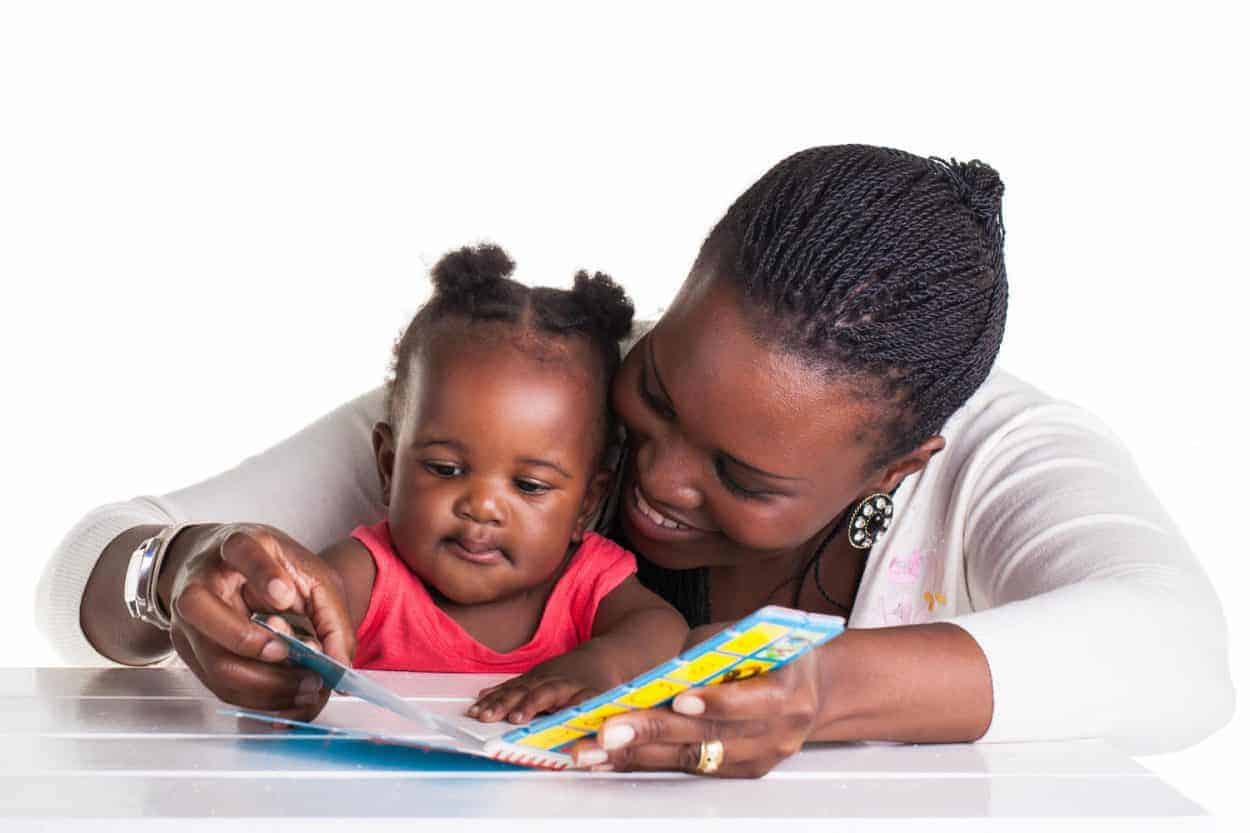 Books are a great way to help your baby develop and become a reader for life!
Books are a great way to help your baby develop and become a reader for life!
At birth a baby has all the brain cells they need for life, but they need to develop the connections (or synapses) between these cells. These connections are the keys to learning. The brain’s ability to grow these connections is greatest between birth and age three. Reading to a child from birth provides the sights, sounds, and touch that will help the brain develop.
Babies learn language by hearing language and they can hear from seven months in utero. By the time your baby reaches their first birthday, they will have learned all of the sounds that they need to speak their native language. You can help them learn these sounds by allowing them to hear different words from an early age. The more you read to your baby, the more words they are exposed too. Sharing songs, stories and nursery rhymes throughout the day calms, entertains and helps build literacy skills.
Children who were read to as babies are also more likely to learn to read at a younger age. They will learn that reading is a positive experience for everyone, and look forward to doing it themselves. Studies show that reading aloud to children is one of the most important things you can do to ensure your child’s later reading success.”
 Reading while cuddling with your baby helps your baby make a connection between the two things your baby loves most – your voice and closeness to you – and books. Reading to your child also helps build social and emotional development. While reading, use many different emotions and expressive sounds. Encourage your baby to look, point and wonder. Stop while you are reading and comment on the pictures. Example: “Where’s the kitty? Here’s the black kitty. What a cute kitty.” Babies love to observe and then imitate, because it strengthens the mental pathways involved in forming memories and ideas. They’ll be more likely to imitate you if you make story time a fun and engaging experience.
Reading while cuddling with your baby helps your baby make a connection between the two things your baby loves most – your voice and closeness to you – and books. Reading to your child also helps build social and emotional development. While reading, use many different emotions and expressive sounds. Encourage your baby to look, point and wonder. Stop while you are reading and comment on the pictures. Example: “Where’s the kitty? Here’s the black kitty. What a cute kitty.” Babies love to observe and then imitate, because it strengthens the mental pathways involved in forming memories and ideas. They’ll be more likely to imitate you if you make story time a fun and engaging experience.
Birth to 6 months
Your baby’s vision will still be adjusting to the world outside your womb. Shortly after birth, they will see best about a foot away from their face, but this will gradually lengthen to near-adult distance by the end of this stage. They will also be adjusting to seeing colours and patterns, so the easiest visuals for them to identify are bold patterns.
Babies are fast learners. At first they won’t understand what you are saying. However, by 4 months, they’ll know their own name, and a few months later, will understand simple commands. This means you need to keep it simple, and remember that what your baby really needs is to hear your soothing, familiar voice. Try to introduce them to lots of different words, but don’t introduce too many at a time, and always go back to old, repeated favourites.
 Near 4 to 6 months, your baby will start to want to touch and feel objects. You can encourage them to get more active by using books to pique their interest. Prop it open near their change table (so long as it’s a baby-safe book) or a similar area. Or try a putting a soft book on the floor for your baby to look at during tummy time. Let them pull on it, pat it or try to grab it for as long as they would like. They’re learning a lot just through these actions.
Near 4 to 6 months, your baby will start to want to touch and feel objects. You can encourage them to get more active by using books to pique their interest. Prop it open near their change table (so long as it’s a baby-safe book) or a similar area. Or try a putting a soft book on the floor for your baby to look at during tummy time. Let them pull on it, pat it or try to grab it for as long as they would like. They’re learning a lot just through these actions.
Some other things to keep in mind when reading to a baby of this age are:
- Choose big books, preferably with rounded edges and durable covers
- For younger babies, focus on books with big bold patterns, preferably in black and white
- Show your baby different faces. Your face is the first thing your baby will learn to recognize, so showing them other faces and expressions will delight them
- Sing-a-longs and rhyming texts are great
6 to 12 months
At this age, your baby is starting to love interacting with the world. It’s a lot harder to keep them still, so story time might have to change a little. Your baby is fascinated by nearly every object at this age. They’ll want to grab things, bang them and possibly start crawling or walking to get things. Make a game out of story time by encouraging your baby to crawl towards the book and grab at it. You can try playing simple games too, like peek-a-boo over the book. Your baby may start learning short commands too, so asking them to turn pages or point out pictures can be a great way to get them engaged too. If they can’t seem to sit still for reading time, then save the book for later, at naptime or bedtime. By making storytime more interactive and fast-paced, you can keep their attention for longer. They’re also ready for more advanced language and communication.
The great thing about picture books is that you can introduce your baby to objects without the objects being in the same room. It gives them a chance to study the images slowly and carefully, and when they do see the real object, they’ll remember it.
Some other things to keep in mind when reading to a baby of this age are:

- Take a break and let your baby just slowly turn the pages
- Let them make up their own story to go along with the pictures
- Put books in every room your baby spends time in, and keep them visible and accessible
- Encourage them to repeat your sounds
- Encourage them to touch the pages, turn the pages or choose a book themselves
- Try board books, they’re easier for them to touch and use
- Find story books about everyday activities they do, like eating or bathing
- Look for books like interactive elements, like lifting flaps, pull strips, fabrics or pop-ups when they are closer to twelve months.
Remember that although babies aren’t born book lovers, they are born lovers of learning. The more you read to them, the more they will learn. They learn to love the feel of the books in their hands, the sound of your voice, the beauty of the illustrations and the joy of a good book.
More tips to help your child:
- Make time to read, sing, talk and cuddle every day
- Reinforce reading concepts, like turning the pages and reading from left to right
- Point out each picture and tell your baby its name to help them start identifying objects
- Don’t worry about reading to your child for more than a few minutes at a time if they aren’t paying attention. Try focusing on pages that your child enjoys
- Don’t worry about following the text exactly, you can skip parts and your baby will not notice
- Engage your baby physically with the story. You can help them clap their hands, wave their arms, or cycle their legs. Or you can do it yourself and entertain them that way
- Make plenty of funny faces and use strange voices
- Read the same books over and over again, and try to use the same emphasis on the same words. Repetition helps build language skills.
- Your baby loves to hear your voice, so you can read almost anything to them.
- Have books all over your home – on bookshelves, in baskets, in toy boxes.
Check out local baby reading times in our area:
- Kitchener Public Library offers Baby Connections, Baby Explore, and One is Fun. Check their website for more info.
- Waterloo Public Library offers Baby Connections and several other programs for infants and caregivers. Check their website for more info.
Happy Reading!
